Our Changing World for Thursday 5 July 2012
Higgs Boson detected
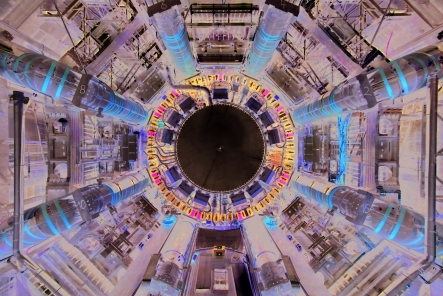
A view of the ATLAS detector at the Large Hadron Collider (image: Claudia Marcelloni, CERN)
After nearly half a century, the hunt for the Higgs boson may finally be over. Scientists at CERN, which operates the Large Hadron Collider (LHC), confirmed this week that they have discovered a particle which fits the description of the elusive "god particle".
Speculation have been intense after CERN unintentionally released a video in which Joe Incandela, a spokesman for one of the two teams hunting for the Higgs boson, stated that a new particle had been observed. Although he stopped short of calling it the Higgs boson, he revealed that it had all the hallmarks of the mysterious particle. "We can see that it decays into two photons, for example, which tells us it's a boson, it's a particle with integer spin, and we know its mass is roughly 100 times the mass of the proton." Confirmation that a Higgs boson-like particle had indeed been discovered came in a press statement from CERN and was also explained in a seminar at the International Conference for High Energy Physics (ICHEP).
The Higgs boson was first proposed by Edinburgh University physicist Peter Higgs in 1964, who welcomed the announcement, acknowledging that he never expected the discovery to happen in his lifetime. Higgs had hypothesised that this elementary particle was necessary to give all other particles mass. The Higgs boson is the final piece of the Standard Model of Particle Physics, a theoretical model which describes all fundamental particles and forces that control our universe. For decades the particle remained impossible to pin down and the hunt for it became the focus for the LHC. Scientists used the LHC to smash together protons at almost the speed of light and to search the debris of collisions for traces of particles that sprang into existence for just a fraction of a second before disintegrating again.
In this interview, University of Auckland nuclear physicist David Krofcheck, who is attending the ICHEP conference, explains the discovery and what it means for our understanding of matter. You can also listen to an earlier interview about his own research at the LHC and, here, you can also watch Peter Higgs' talk "My life as a Boson".
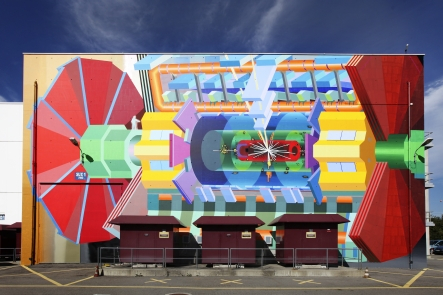
This large mural of the ATLAS detector was painted by Josef Kristofoletti. It shows the detector with a photon collision superimposed, depicting what a Higgs boson may look like (image: Claudia Marcelloni, CERN)
Enzymes and Cancer
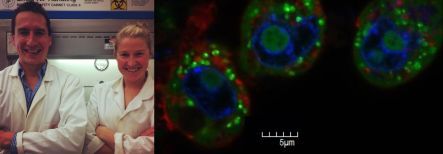
From left to right: David Ackerley and Janine Copp, and bacteria invading mammalian cells. Bacteria that preferentially invade cancer cells in a similar manner can potentially be used to deliver genes that will sensitise the tumour to prodrugs. (microscope image: Laura Green)
David Ackerley’s laboratory at Victoria University uses bacteria as biofactories to create enzymes of interest. Enzymes are proteins that catalyse chemical reactions in cells, and by using directed evolution, specific functions of the enzymes can be selected for.
In particular, David Ackerley and Janine Copp are working on a new cancer treatment, and while it may be some time before the therapy can be used in people, the idea is that a patient would be given the prodrug first. A viral vector would then deliver the gene for the enzyme directly to the cancer cells. This vector would be specific to cancer cells, so healthy tissue would be unaffected. The prodrug would then be activated by the enzyme and a toxic metabolite released that kills the cancer cells.
Diagnosing Cancer
 Christopher Pease (pictured right) is an anatomical pathologist at Aotea Pathology and he spends a lot of time looking at tissue to make a diagnosis of disease. When a specimen arrives, representative sections are stained and sliced very thinly and made into slides. These are then examined under the microscope.
Christopher Pease (pictured right) is an anatomical pathologist at Aotea Pathology and he spends a lot of time looking at tissue to make a diagnosis of disease. When a specimen arrives, representative sections are stained and sliced very thinly and made into slides. These are then examined under the microscope.
In particular, Christopher is looking for patterns of cells which are indicative of cancer, or other abnormalities. To do so, he needs to know the difference between patterns of cells which are normal and those which are irregular. Different coloured stains are also used to reveal particular aspects of cancer, and complex cases are often discussed with colleagues. It is important to identify a cancer accurately so that the patient can receive the right treatment, and the professional satisfaction of successfully diagnosing cancers has to be weighed up against the sad fact that the cancer patient can face a very difficult time ahead.
Breeding a Psa-Resistant Kiwifruit Cultivar
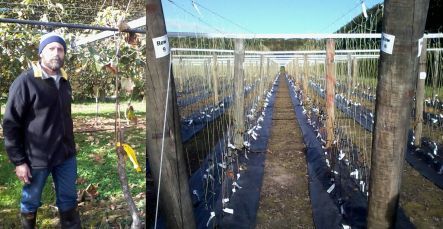
Luis Gea stands next to a kiwifruit cultivar in the Te Puke Research Orchard that is infected with Psa-V (left), and new cultivar seedlings are intensively planted to see if they succumb to Psa-V in the field (images: A. Ballance)
Pseudomonas syringae pv. actinidiae (Psa) is a pathogenic bacterium that infects kiwifruit, or Actinidia, species. It was first identified in Japan more than 25 years ago, and various strains of it are now present in eight countries. It was identified in New Zealand in November 2010. There are two strains of Psa in New Zealand – the more virulent strain which is causing the most concern is known as Psa-V (v = virulent), while the less virulent strain is Psa-LV. Psa-V has been identified on more than 1220 kiwifruit orchards in New Zealand, and is causing widespread vine deaths.
The gold Hort16A variety of kiwifruit is very susceptible to Psa-V, which also affects the other commonly grown cultivar, the green Hayward variety, although not as badly. In mid-June kiwifruit company Zespri announced plans to replace more than 1500 hectares planted in the gold Hort16A variety with Gold3, a new variety that has already been commercialised and seems to be more Psa tolerant.
The outbreak of Psa-V in New Zealand has triggered a large research programme, including work by Plant and Food Research into the development of more Psa tolerant and resistant cultivars. Plant and Food Research already had a major kiwifruit breeding programme underway at its Te Puke research orchard, focusing on traits such as flavour, colour, storage and crop yield. Now it is in the process of screening more than 100,000 cultivars in the hope that a plant that already has good commercial qualities might also be Psa resistant. Alison Ballance visits the orchard and kiwifruit breeder Luis Gea shows her around some of the trials, including the germplasm block, which contains about 40 original species of kiwifruit from China and other parts of Asia.
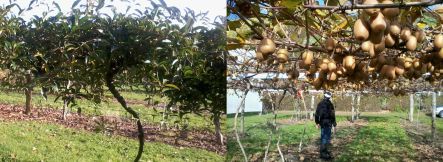
An original evergreen species of kiwifruit in the germplasm collection (left), and a new cultivar of kiwifruit that has red flesh (images: A. Ballance)